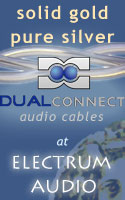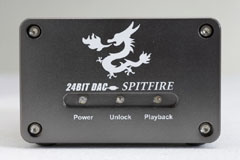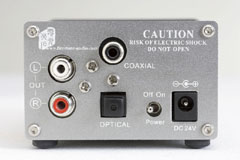
You are reading the older HTML site
Positive Feedback
ISSUE
24
firestone audio
Spitfire DAC
as reviewed by Ed Kobesky


 |
|
|
You are reading the older HTML site
Positive Feedback
ISSUE
24
firestone audio Spitfire DAC as reviewed by Ed Kobesky
|
|
|
On Friday, December 23, the last thing a 30-year-old Catholic boy is thinking about is the latest DAC from a Taiwanese firm (www.firestone-audio.com) whose products he has thus far been lukewarm about. It's Christmas Eve Eve, and that means leaving the office well before five, heading to the cigar lounge for an illicit Montecristo Edmundo with the gang before braving the mall to snag some last-minute CDs for the loved ones. Did I mention the five pounds of Alaskan king crab on dry ice in my trunk? It was a good holiday. Somehow, I found myself home before 7 PM. After dinner, I found myself with a little time for music. Just then, UPS arrived with the Samsung DVD-HD841 universal player I had ordered ($250 retail, $70 for a refurbished unit on eBay). Despite the Samsung's competent audio section, I had no intention of listening to Redbook CDs without a DAC, so I busted out the Firestone Audio Spitfire ($250). I hadn't used a DAC for years, as I didn't see the need. I owned a Meridian transport/DAC combo in the early 90s and a Rotel stack in the late 90s, but CD playback has now progressed to the point that a $500 CD player would trounce either. I've been using one-box players for years. So it was a shock when I wired up the Samsung to the Spitfire DAC—using half of a pair of Audioquest Alpha Snakes ($15) in lieu of a digital coax—and found the improvements to be far from subtle. Later, I tossed the Supplier power supply ($100) into the mix and was even more impressed. These three components sounded like a $1000 player, for less than half that amount! Christmas came early that night, and I spent a few hours exploring my CD collection and wondering at the sound of the Spitfire/Supplier duo. Take, for example, Madonna's Confessions on a Dance Floor (Warner 49640-2). It had always sounded wild and wooly, with tons of uncontrolled bass floating in a murky mix. I thought this was an intentional homage to sleazy 70s disco. Then I heard it through the Spitfire. All of a sudden, the bass was tight and punchy, Madonna's voice was focused, and the whole thing hung together. I played the first Madonna album I ever owned from start to finish, and it sounded wonderful. Randy Newman's 1999 release, Bad Love (Dreamworks; DRMD-50115), benefited less from the Spitfire, though the DAC managed to add an additional degree of separation between instruments and a certain naturalness to the voice and piano that had been lacking. I couldn't compare the CD and DVD sides on the new Fiona Apple DualDisc of Extraordinary Machine (Epic EN96530) because the Samsung refused to read the CD side. Nevertheless, the DVD side sounded rich, with a tremendously focused midrange and commendable control of the lower octaves. Apple's voice had that elusive you-are-there quality that is unique to audiophile-grade reproduction. Once again, I preferred the sound when using the Spitfire. Christmas Eve arrived, so I popped in Vince Guaraldi's A Charlie Brown Christmas (Fantasy SACD FSA8431), a disc I can listen to all day. First I played the SACD layer on the Samsung, using a pair of awesome (and affordable) Art Audio IC3 interconnects. It sounded very, very good, with plenty of air and space around the piano and natural decay. When I played the CD layer through the Spitfire, the difference was not startling. The music was a bit crisper and more focused. The SACD layer sounded more "analog," but the CD layer sounded "digital" in a good way. Inside the Spitfire's compact chassis is Burr-Brown's PCM1793, a 24-bit chip capable of 192 kHz sampling, but limited to 96 kHz by the unit's Crystal CS8414 receiver. The analog output is a swappable Burr-Brown OPA2604AP. The DAC can be linked to the optional Supplier power supply via a short cable. I see no reason not to use them both. Firestone guarantees that you'll notice a difference in dynamics (as I did), or your money back. Another reason to buy it is that the Supplier allows to you upgrade to a better C7 power cable. The Spitfire, unfortunately, uses a wall wart. I suppose you could find a compatible Elpac power supply, but I would just spring for the Supplier and add a PS Audio Power Punch cord for $50. The Spitfire and Supplier are housed in the same sturdy, well-finished cases as the rest of Firestone's Cute product line. Both units feature the tiny, rear-mounted on/off toggle switches seen on all Firestone products. I hate them, but in this case it didn't matter because I left both units on all the time. They sounded better that way. On a few occasions, while fast-forwarding, the Spitfire lost digital lock with the Samsung, but a flick of the Samsung's power switch was sufficient to reset the units. Aside from that, the Spitfire was completely reliable. For the record, I tried a Monster Cable coax that cost around $40 at RadioShack. I heard no difference between the Monster and the Audioquest, so I returned it. In my view, the only reason to shell out more than a few bucks for a dedicated coax cable is for the extra shielding, or if you need a very long run. Otherwise, save your money for a power cord or interconnect upgrade. Compared to my Rega Planet, the Spitfire rig sounded less rhythmic, with just a bit less finesse. There was no contest, however, between the Spitfire setup and any of my mass market players. It was even sharper sounding than my old NAD C521i, which I liked a lot. Soundstaging was excellent, particularly front to back. Imaging was incredibly precise for the money, and just as shockingly, every voice and instrument had proper scale. Nothing sounded too tall or too wide. The separation between instruments was good, and only in the most complex passages did the music sound a little hard. The Spitfire exhibited the kind of punchy, slightly forward sound I've come to expect from the very best Rotel players. I could—and did—listen to it for hours on end. The grand total for a Spitfire/Supplier/Samsung/Audioquest setup like mine is $485. You can get some very good CD players for that kind of money, yet the Spitfire rig sounds more refined than most of them—more detailed and more nuanced. Plus, don't forget, for $485 you not only get outstanding Redbook playback, but credible DVD-A and SACD performance by running an analog interconnect from the Samsung to your preamp. That's a ton of flexibility for under $500, and you can duplicate it at home with your choice of el cheapo universal players from Toshiba, Pioneer, Yamaha, or others for about the same price. Or you can simply hook the Spitfire up to that old, built-like-a-tank CD player that's gathering dust in your closet. In today's consumer landscape, where grungy-sounding DVD players are increasingly doing double duty as CD players, a reasonably priced product like Firestone's Spitfire is more valuable then ever. I've toyed with many low-priced DACs, and found none of them worth the effort and expense until now. The Spitfire and Supplier are highly recommended to anyone looking for a cheap, fuss-free upgrade that really makes a difference. Ed Kobesky
Firestone Spitfire DAC
Firestone Supplier PS Firestone AudioAudio www.firestone-audio.com
US
|